Welcome to Chapter 2, where we’ll discuss the topic that all feathered friends will appreciate – Chicken Coops and Runs! Chickens are happy creatures, but a suitable home is a must-have for them to lay the foundation for their happiness. If you’re starting a chicken flock or already have one, ensuring their living quarters are safe, comfortable, and cozy is crucial.
Expert tip: Figure out your chicken coop and run setup before you get your birds! It’s like preparing a surprise birthday party for your feathered friends, except the surprise should be the coop, not that they’re suddenly homeless. They’ll appreciate a cozy and secure home more than a last-minute scramble to build one. So, take your time to plan, measure, and build a coop and run tailored to their needs. They’ll love you for it, and you’ll love them for the delicious eggs they lay!
Crowing About Coops: A Guide to Your Chickens’ Home Sweet Home

Before we get into the nitty-gritty details, let’s first answer some of the burning questions you may have about chicken coops.
What is a Chicken Coop? Understanding Your Chicken’s Home Base
A chicken coop, also known as a henhouse, is the main living space for your chickens. It’s a place for them to sleep, lay eggs, and take cover from the elements. Coops come in all shapes and sizes, from basic to fancy, but all should provide your chickens with the necessary protection and security. Chicken coops are not much different than a human house, and they have all the basics, like walls, a roof, ideally some windows to let some light in, and a door or opening they can travel in and out of.
What is a Chicken Run? Run, Chicken, Run!
A chicken run is an outdoor area attached to the coop where chickens can roam freely and enjoy fresh air and sunshine. A good run should provide plenty of room for chickens to stretch their legs, peck at the ground, and engage in their natural behaviors. The chicken run is their play area and where they hang out most of the day. The run is usually an enclosed area with some fencing.
Components of a Chicken Coop and Run. All the Fixin’s for a Happy Hen House
A chicken coop and run comprise several components, including nesting boxes, roosts, windows, doors, feeders and waterers, and more. Understanding what each part does and how it helps your chickens is essential to creating the perfect home. For example, nesting boxes and roosts provide the chickens with a safe, comfortable place to lay eggs and sleep. Windows let fresh air in while keeping predators out, while doors give you easy access to the inside of the coop. If you live in an area with flying predators, like hawks or owls, the run should have a secure roof or cover and strong fencing tall enough to keep out potential predators. We’ll discuss the components a bit later in the chapter.
Should I Buy or Build a Coop and Run? Making the Coop Decision
This is a classic question in the world of chicken keeping. Both options have pros and cons; the answer ultimately depends on your specific needs and budget. Building a coop is like putting together a chicken puzzle with many more tools and time involved. And buying a coop is like ordering takeout, easy but with a pricier bill.
Essential Components of a Chicken Coop and Run: Cooping Up Your Cluckers
A chicken coop and run is the home sweet home for your feathered friends, and it’s essential to make sure it has everything they need to live comfortably and happily. Here are the vital components of a chicken coop and run:
Nesting Boxes: A Place to Lay Eggs, Not a Cat’s Playhouse!

When it comes to chicken coops, one of the essential components is the nesting boxes. These are located in the chicken coop. These boxes provide chickens with a safe, cozy place to lay their eggs, so having enough for your hens is essential. Typically, you’ll want one nesting box for every three to four hens in your flock.
Ensure the boxes are large enough for the chickens to sit inside comfortably and have a low, slanted floor or a low barrier to keep eggs from rolling out. And the most important rule is never to let your cat in there, as it’s not a playhouse for them!
You’ll need to add some nesting materials to make it comfortable for your hens to lay eggs:
- Straw vs. wood shavings — Chickens need a quiet, comfortable place to sleep and lay eggs. The most common bedding materials are straw and wood shavings. Straw is a good choice because it is soft, absorbent, and easy to clean. Wood shavings are also a good option, but they can be dusty and contain allergens.
- Soft and comfortable materials — The bedding should be soft and comfortable for the chickens to stand, sit, and sleep on. Yes, some hens may choose to cuddle up and sleep in the nesting boxes—but not all of them. Avoid using rough or abrasive materials, which can damage the chickens’ feet.
- Easy to clean and replace — The bedding material should be easy to clean and replace. It should be free of debris, such as rocks or sticks, and it should be changed regularly to maintain a clean and healthy environment for the chickens.
- Absorbent and moisture-wicking — The bedding material should be able to absorb moisture and prevent the accumulation of ammonia and other harmful substances. Choose materials that can wick away moisture, such as straw or wood shavings, and change the bedding regularly to keep it dry and clean.
See also: Chicken Nesting Materials: Best Options for Chickens
Roosts for Sleeping: A Chicken’s Bedroom in the Sky!

Like humans, chickens need a good night’s sleep to be happy and healthy. That’s where roosts come in! Roosts are horizontal bars or poles where chickens perch to sleep. They’re in the chicken coop, raised off the floor, and attached to the walls. Roosts should be sturdy and at least a foot off the ground to protect the chickens from predators. Chickens will jump on the roost, grasp it with their feet, get comfortable, and sleep while sitting. They should also be wide enough for the chickens to balance comfortably but not too wide to discourage snuggling. Your chickens love to snuggle with each other to keep warm, making the coop feel like home.
Chicken-Friendly Flooring: Soft Landings and Easy to Clean Up
The coop’s floor should be made of chicken-friendly materials, such as sand, wood shavings, or straw, to provide a comfortable and safe place for your chickens to walk. Sand is an excellent choice for the floor of a chicken coop because it’s soft, comfortable, and easy to clean up. Your chicken will poop a lot in the chicken coop while they sleep. You rake out any droppings and give the sand a new sprinkle to keep it smelling fresh and clean. Plus, the hens will love the feel of sand between their toes! Just imagine a day at the beach with your feathered friends. What could be better?
Ventilation: Letting the Good Air In and Keeping the Bad Air Out
Ventilation is a breath of fresh air for your feathered friends. By letting fresh air in and circulating the air inside the coop, you can prevent the buildup of harmful fumes and moisture, leading to health issues and respiratory problems in your chickens. The best way to achieve proper ventilation is by incorporating windows and roof vents into the coop’s design. Windows allow air exchange, while roof vents help draw out hot, stagnant air.
Insulation: Keepin’ it Cozy for Your Cluckers!
Insulation helps regulate the temperature inside the coop and run, making it comfortable for your chickens, no matter the weather outside. Insulation can keep the coop cool during hot summers if you live in a warmer climate. And if you live in a colder climate, insulation can keep your hens cozy and warm during chilly winters. Insulation can also help reduce condensation and prevent mold growth, making it a must-have for any chicken coop and run.
Lighting: Brighten Up Your Chickens’ Day
Lighting is a critical component of a chicken coop and run, as chickens need light to lay eggs and to keep them healthy. A source of light in the coop, such as a window or skylight, can help ensure the birds are not laying eggs in complete darkness. However, it’s essential to ensure that the light source is not too bright, as direct sunlight shining into the nesting boxes can be stressful for the birds while they are laying. The goal is to provide enough light to keep the coop bright and cheerful without disturbing the chickens. So, it’s a balancing act, just like an egg-cellent eggnog recipe!
Chicken Waterer: Hydrating Your Fine-Feathered Friends
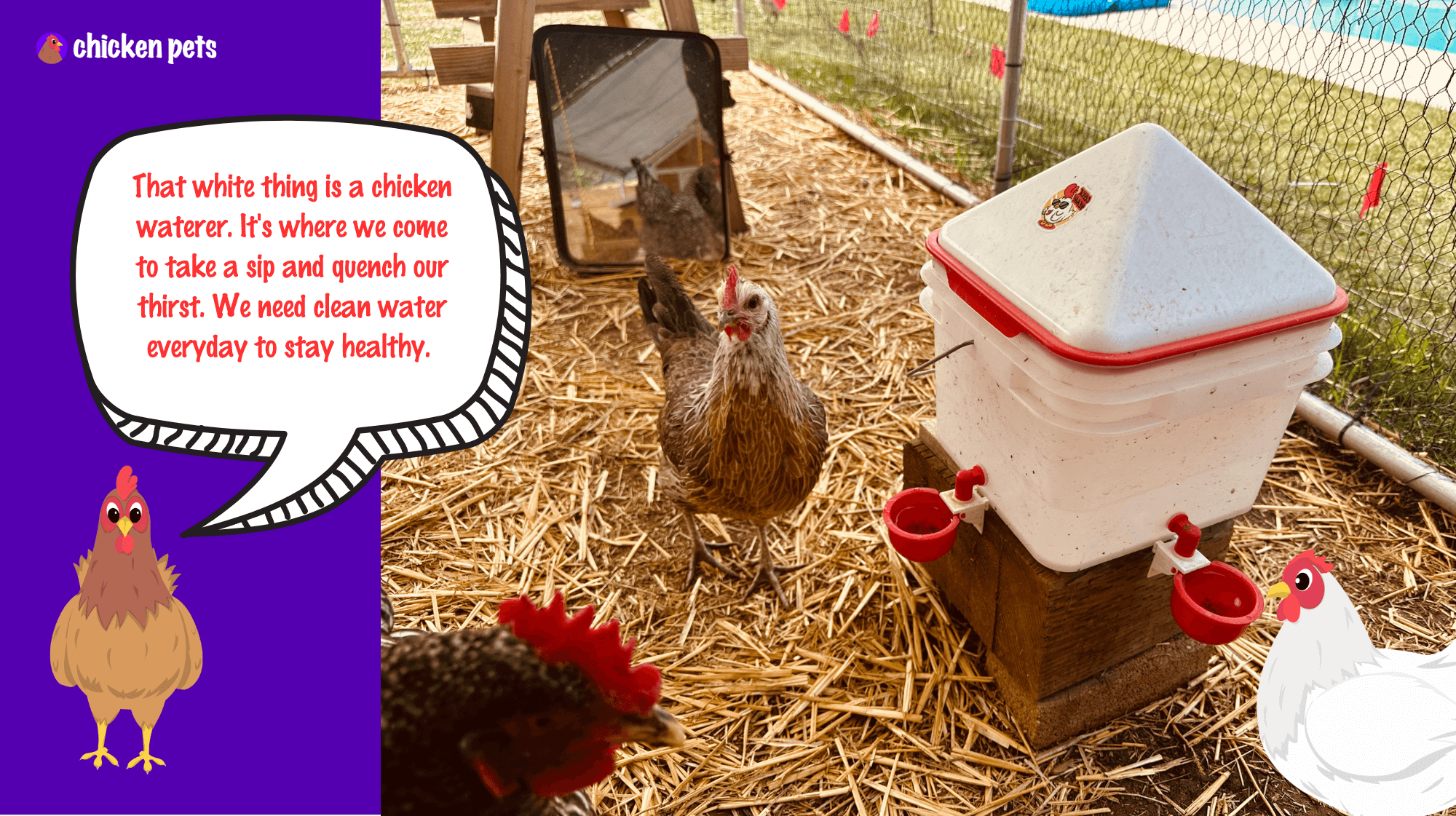
A chicken waterer is precisely what it sounds like, a container that holds water for your chickens to drink from. The best waterers are sturdy, non-toxic materials and have a spill-proof design to keep their environment clean and hygienic. You can opt for a traditional watering can or a more high-tech automatic waterer that uses gravity or a vacuum to keep the water supply flowing. The waterer is usually kept somewhere in the chicken run, outside of the coop. Ensure your chickens access fresh water; hydration is vital to their health and happiness.
Chicken Feeder: Fueling Up Your Flock

Like us, chickens need three square meals daily (ok, maybe not precisely three square meals, but you get the idea). A chicken feeder is where they get their daily grub, and you want to ensure it’s good. Like the waterer, your chicken feeder is kept somewhere away from the coop in the chicken run. The best feeders are made of durable materials and have a design that prevents waste and keeps feed dry and accessible. Choose from the traditional hopper or modern automatic feeders – whatever suits your fancy. And don’t forget, a well-fed chicken is a happy chicken!
Grit Dispenser: The Secret to Strong Shells
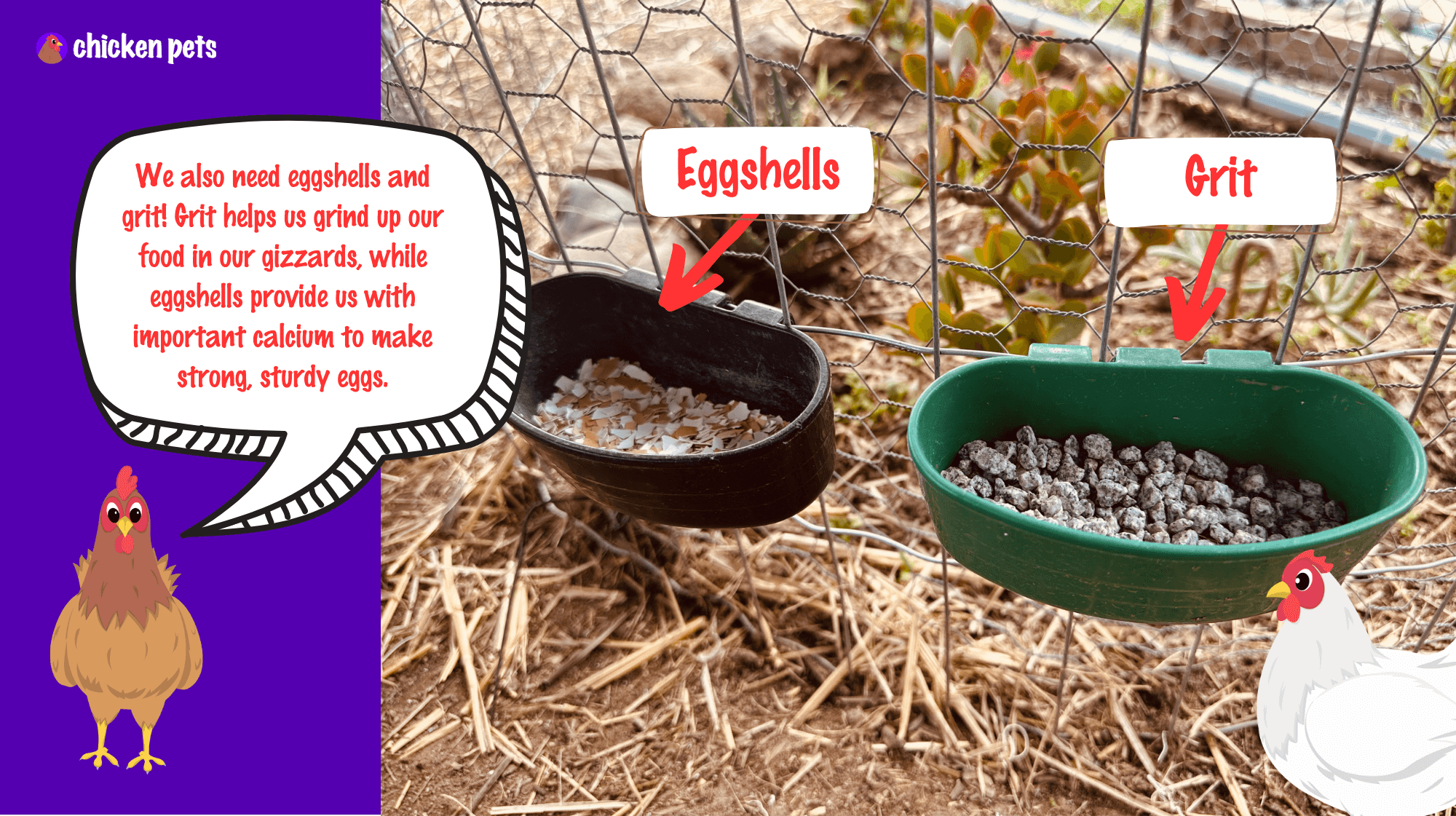
What is chicken grit? – Chicken grit is a small, insoluble rock or mineral consumed to help grind up and digest food. Chickens don’t have teeth, so they need grit in their digestive system to help break down tough and fibrous foods like grains, vegetables, and insects. It also helps their gizzard, the part of the digestive system that grinds food, work more efficiently. Providing your chickens with a constant supply of grit is essential to keeping them healthy and happy.
A grit dispenser is simply a container that holds grit and allows your chickens to access it whenever needed. Keep the grit dispenser close to the waterer and feeder. They’ll know when they need grit! The first time you see your chicken eating little rocks is jarring. But it’s normal. Choosing a dispenser that is easy to fill and clean and won’t spill or waste the grit is essential. With a steady supply of grit, your chickens will be well on their way to strong and healthy shells. Now that’s what we call a happy ending!
Dust Bath: A Dusty Affair
Chickens love to take a dust bath! This isn’t your typical bubble bath, but it’s a must-have for keeping your chickens clean and healthy. A dust bath is a shallow hole filled with dry dirt, sand, or ash. Chickens will roll around in it, spreading dust over their feathers. The dust will help remove any parasites or dirt from their feathers. The best part? They look like they’re having a blast! Just be prepared for a bit of a mess, but it’s worth it for the health of your feathered friends. The ideal location for your dust bath is under the chicken coop (remember, your chicken coop should be raised off the ground). When ready to clean up, rake out the old dirt and put in with the new.
Perches for Preening: Give Your Chickens a Lift to the High Life
Who says chickens can’t enjoy a little R&R? An outdoor perch is the perfect place for your feathered friends to take a break, catch some rays, and soak up the scenery. These high-flying hangouts should be sturdy, secure, and weather-resistant to keep your chickens comfy and protected from predators. And with a clear view of the surrounding area, they’ll feel on top of the world. So, give your chickens a lift to the high life with a cozy outdoor perch. They deserve a little R&R, and you’ll love watching them soar to new heights!
Optional Components of a Chicken Coop and Run: A Fowl’s Playground
In addition to the essential components of a coop and run, you can add some optional features to enhance their experience and provide plenty of entertainment. These features range from simple chicken toys to elaborate play structures that keep your birds busy and stimulated. So let’s get ready to bring on the bells and whistles (and swings and mirrors) for our feathery friends! These additions will have them crowing with excitement!
An Outdoor Perch for the Birds of Play

Just like chickens need a place to roost at night, a well-built outdoor perch can provide an excellent spot to catch a nap during the day. They’ll jump up on the perch to chill during the afternoon or have a perch party while preening (grooming) after eating. An outdoor perch should be sturdy, secure, and made of weather-resistant material. It’s also a great idea to place it high enough that your chickens can enjoy a clear view of the surrounding area but are still protected from predators. The high life is the life for these birds, and a good perch is a great way to ensure they get plenty of fresh air and relaxation during the day. So give them a lift, and watch them soar to new heights.
Chicken Toys: More Than Just Pecking Order
Who says only dogs and cats get to have all the fun? Your chickens deserve to play too, and there’s no better way to do that than with a few well-placed toys. Chicken toys can range from balls for them to chase to hanging toys for them to peck at. These toys are fun for your birds and help keep them physically and mentally stimulated, which is essential for their overall health and well-being. So don’t be afraid to get creative, and let your chickens play.
Vanity, Thy Name is Chicken

What’s better than looking in the mirror and seeing your fabulous self? Why not give your chickens the same opportunity with a few strategically placed mirrors? They are great for a quick pick-me-up and can provide entertainment for hours. Who needs TV when you can watch your chickens check themselves out all day long?
A Melody for Your Chickens to Peck
Bored birds are unhappy birds, and what better way to cure boredom than with a good old-fashioned pecking session? Bells and xylophones are great options for mental stimulation and physical exercise for your chickens. Just make sure to choose chicken-friendly bells or xylophones, or you may end up with more holes than notes!
Treats in the Sky
Everyone loves a good treat, and your chickens are no exception. Hanging nets filled with treats is a great way to provide tasty fun for your birds. Not only will they enjoy a delicious snack, but they’ll also get to work on their balance and coordination skills as they figure out how to get to the treats. It’s a win-win situation!
Flock and Roll, Feed Blocks
Imagine your feathered friends rocking out to their favorite snack – a compressed block of grains, seeds, and other nutrients called a flock block. These bad boys are like a concert in a brick – they provide your chickens with the supplemental nutrition and entertainment they need to live their best lives.
Flock blocks are the ultimate chicken party favor, sold in a compressed brick or block form that you can easily place in the coop or run for your chickens to peck at. They’re a convenient and low-maintenance way to give your chickens the extra nutrition and stimulation they crave, especially when foraging opportunities are limited.
But let’s get real. A chicken can’t live on flock blocks alone. They’re best used as a supplement to a well-balanced diet that includes a variety of grains, seeds, fruits, vegetables, and protein sources like insects or worms. And just like with any concert, you want to ensure you’re getting the good stuff – choose a high-quality flock block free from harmful chemicals or additives.
Swing into Action
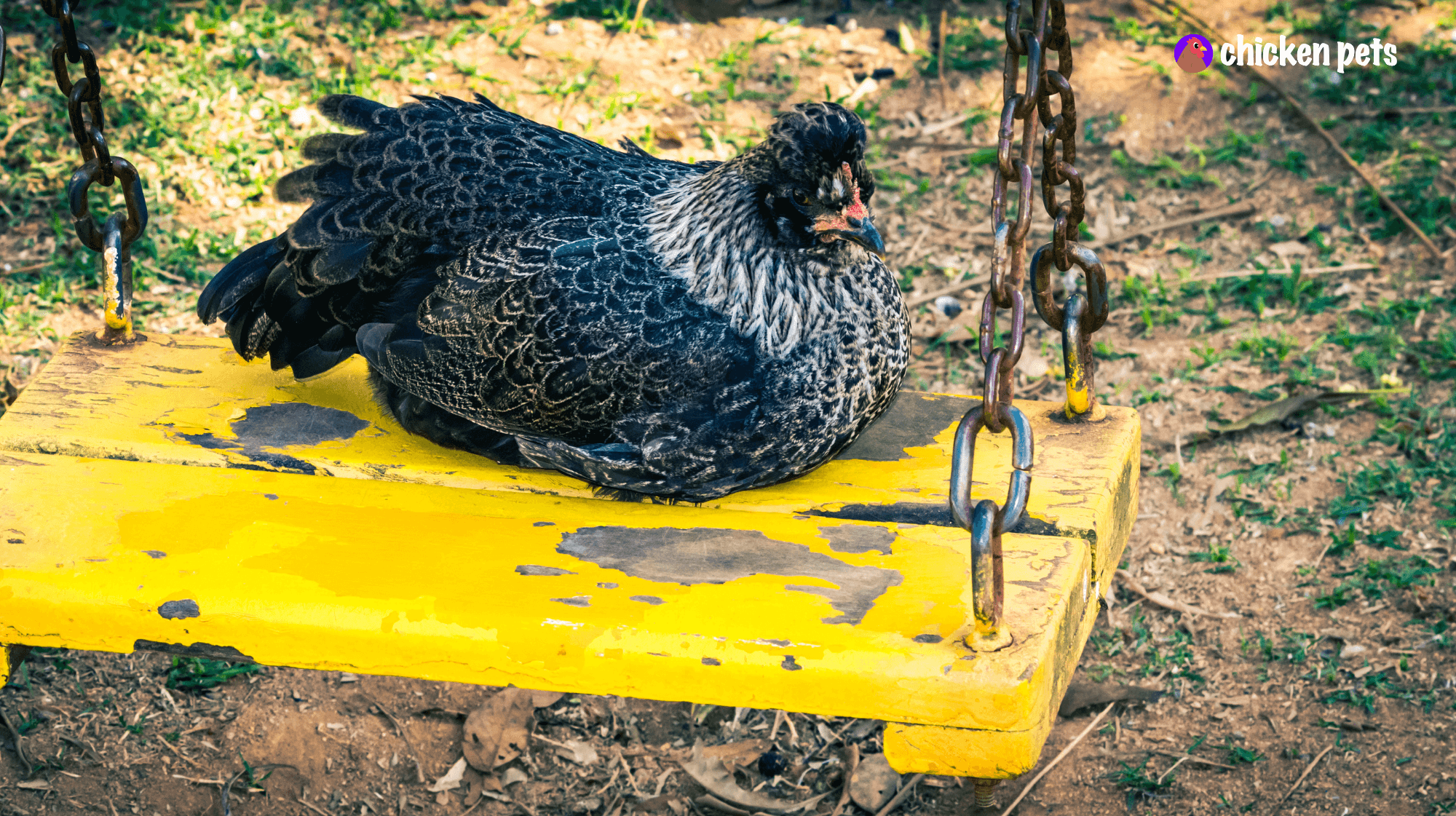
Why should the kids have all the fun? Chicken swings are a great way to provide some physical exercise and mental stimulation for your birds. Whether they’re taking a nap or playing, a swing offers some feather-flying fun. Just make sure it’s sturdy and secure, and watch your chickens swing into action!
All the Bells and Whistles
A chicken coop and run should have the necessary equipment and accessories to keep your chickens happy and healthy. And don’t forget the little extras, like a dust bath area and a perch for watching the world go by.
With all these essential components in place, your chickens will live life and cluck with joy in their new sweet home.
Buying a Chicken Coop. Like Ordering Takeout!

Thinking of treating your chickens to a cozy and comfortable new home? One of your options is to purchase a pre-made chicken coop. While this choice may seem simple, there are several pros, cons, and essential factors to remember when choosing the proper coop for your feathered friends.
Pros of Buying a Pre-made Chicken Coop
- Convenience —A pre-made chicken coop is ready to use right out of the box, saving you time and energy compared to building one from scratch.
- Cost-effective —In some cases, buying a pre-made chicken coop may be more cost-effective than building one, especially if you factor in the cost of your time plus materials, tools, and handi-ness.
- Professional design —Most pre-made chicken coops are designed by professionals, ensuring they are safe, comfortable, and functional for your chickens.
Cons of Buying a Pre-made Chicken Coop
- Limited options —You may have limited options when choosing your chicken coop’s size, style, and materials.
- Poor construction —Some pre-made chicken coops may be made with poor-quality materials and construction techniques, which could compromise the safety and comfort of your chickens.
- High price tag —Depending on the size and quality of the coop, buying a pre-made chicken coop can be quite expensive.
Types of Chicken Coops You Can Buy
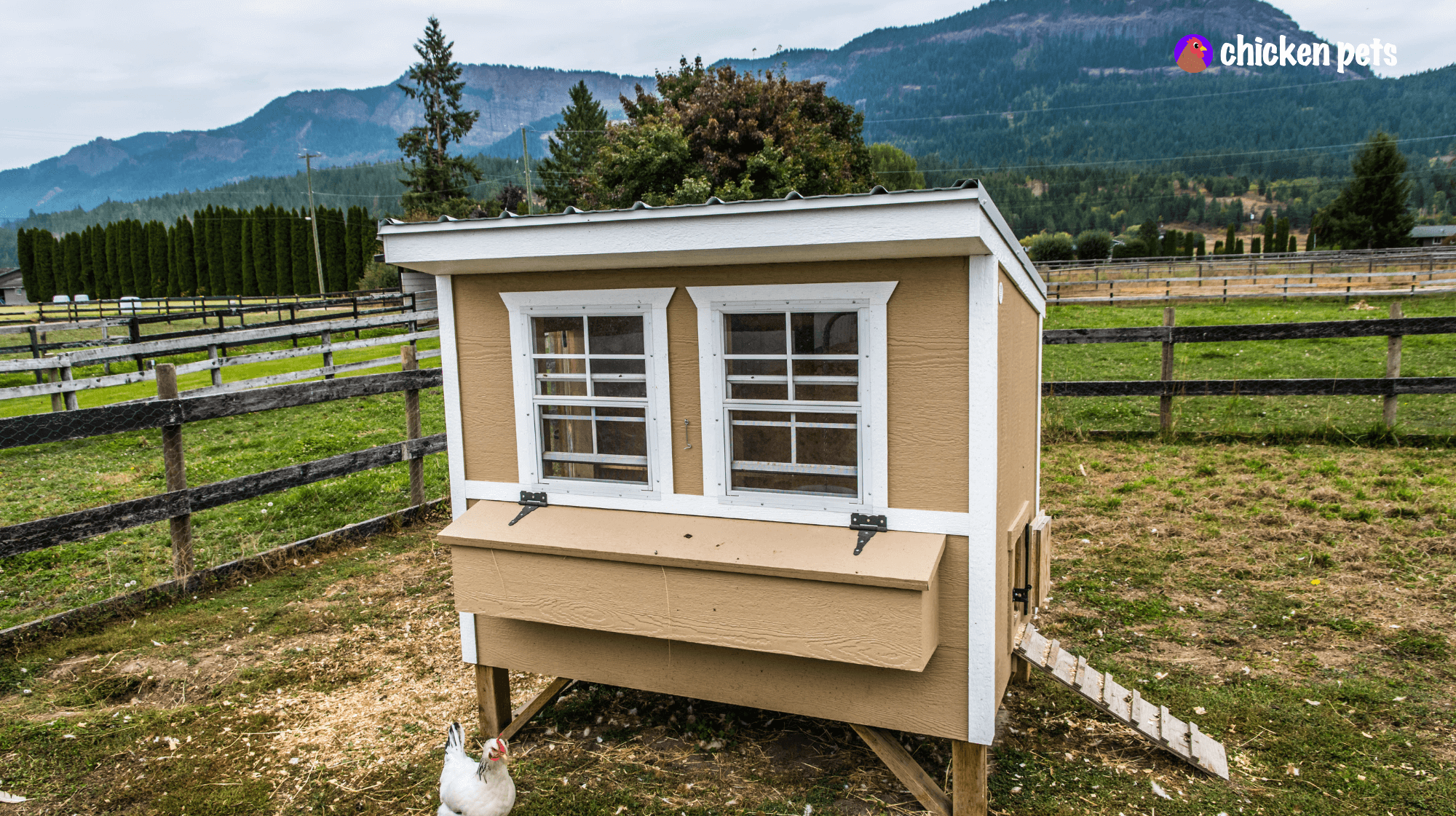
Several pre-made chicken coops are available, each with unique features and benefits. Some popular options include:
- Traditional henhouses —These are classic, A-frame style chicken coops that provide a spacious, sheltered area for your chickens to roost and lay eggs.
- Portable coops —These compact, lightweight coops can be easily moved around your yard to give your chickens access to fresh grass and sunlight.
- Chicken tractors —These are movable coops with wheels that can be pulled around your property, giving your chickens a new, clean area to live in daily.
- Large coops —A large coop may be necessary to provide enough space and shelter if you have a lot of chickens.
Considerations for Size and Materials When Buying a Chicken Coop
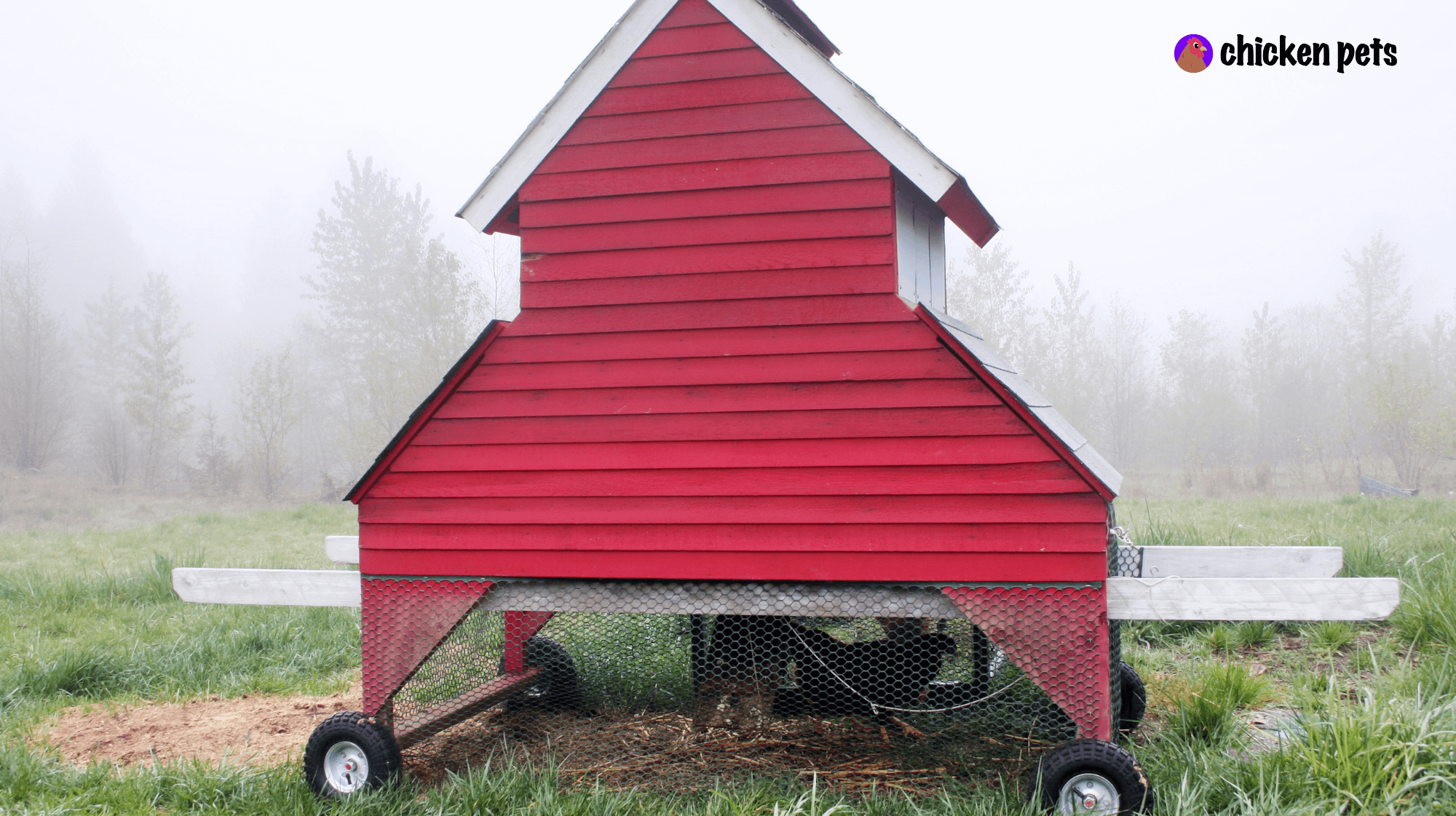
When choosing a pre-made chicken coop, it’s essential to consider the size of your flock and the materials used in its construction. Here are some things to keep in mind:
- Size —Make sure to choose a big coop for your chickens to move around freely and comfortably. A general rule of thumb is to provide about 3-4 square feet of space per chicken.
- Materials —Look for a coop made from sturdy, durable materials that can withstand the elements and provide proper insulation and ventilation. Common materials include wood, metal, and plastic.
- Ventilation —Good ventilation is essential to prevent the buildup of harmful ammonia fumes and to keep your chickens cool and comfortable. Look for a coop with plenty of windows or vents to allow good airflow.
How to Choose the Right Coop for Your Needs and Budget
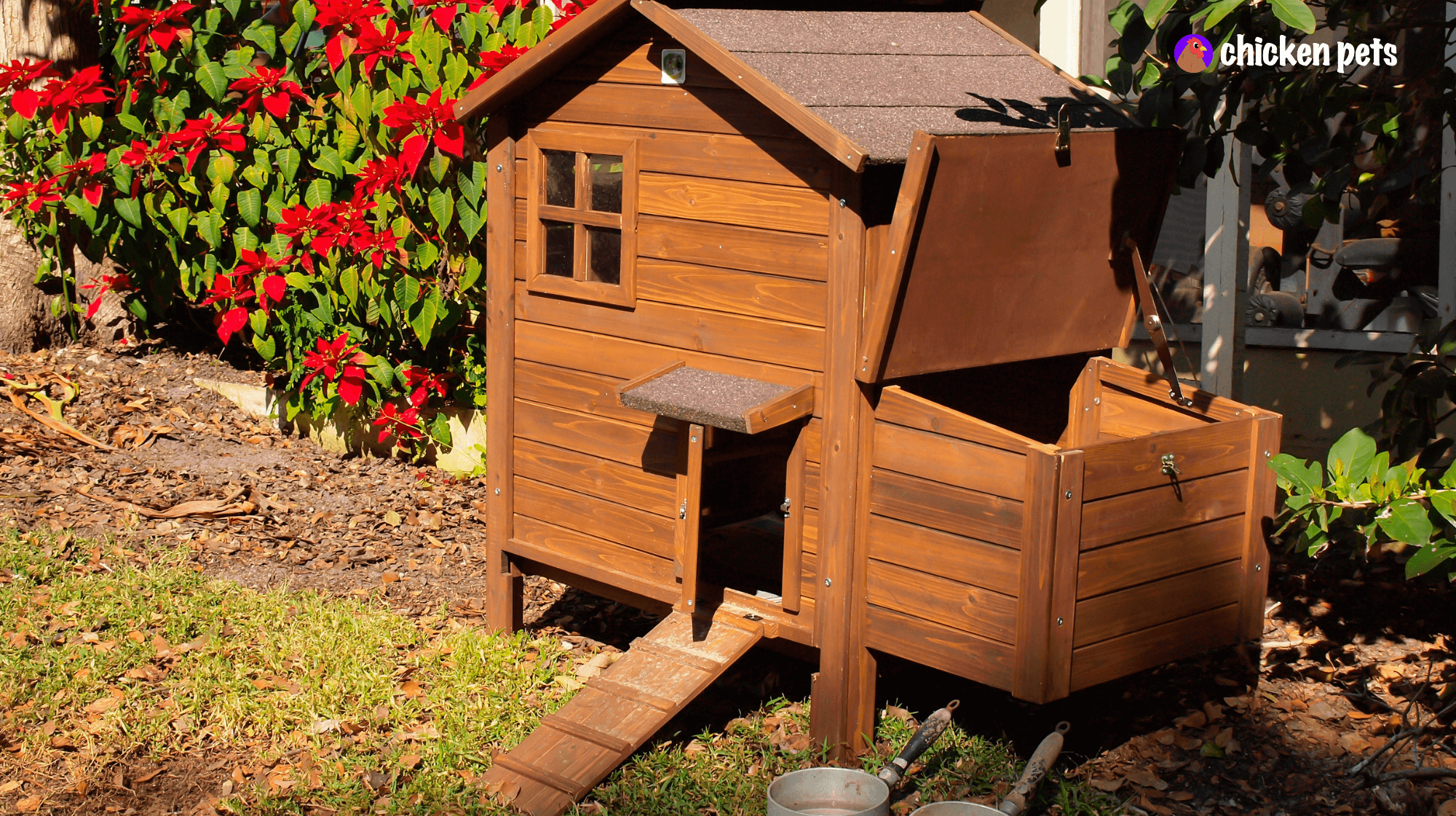
When shopping for a pre-made chicken coop, choosing one that meets your needs and budget is essential. Here are some tips to help you make the right choice:
- Determine your budget — Determine how much you can afford to spend on a chicken coop before shopping. This will help you narrow down your options and avoid overspending. Consider the materials, size, and additional features you want, and determine a realistic budget for your needs.
- Assess your space —Consider the space available for your chicken coop. Measure the area where you plan to place the coop and ensure that the coop you choose will fit comfortably. Remember that the coop will need to be accessible for cleaning and egg collecting, so make sure there is enough room for this.
- Number of chickens —Consider how many chickens you plan to house in your coop. You’ll need to ensure enough space for each chicken to have their own roost and enough room for them to move around comfortably.
- Features —Consider the features you want in your coop, such as insulation, ventilation, lighting, and a nesting box. List your crucial features and prioritize them based on your budget and space.
- Materials —Consider the materials used to construct the coop. Choose materials that are durable, weather-resistant, and easy to clean. Ensure the coop is well-constructed and sturdy enough to keep your chickens safe and secure.
- Warranty and customer service —Check the manufacturer’s warranty and ensure you understand the terms and conditions. Research the company’s customer service and read reviews from previous customers to ensure you get a quality product with good support.
Where to Buy Chicken Coops
You can buy chicken coops from various retailers, both online and in-store. Some popular online retailers include Amazon, Tractor Supply, and Wayfair. You can also check your local hardware or pet store for pre-made coops. Remember, no matter where you buy your coop, ensure it meets your needs and budget.
See also: Omlet Chicken Coop Eglu Cube Review – This is an excellent starter chicken coop for beginner farmers.
Building Your Chicken Coop – From Clucks to Construction
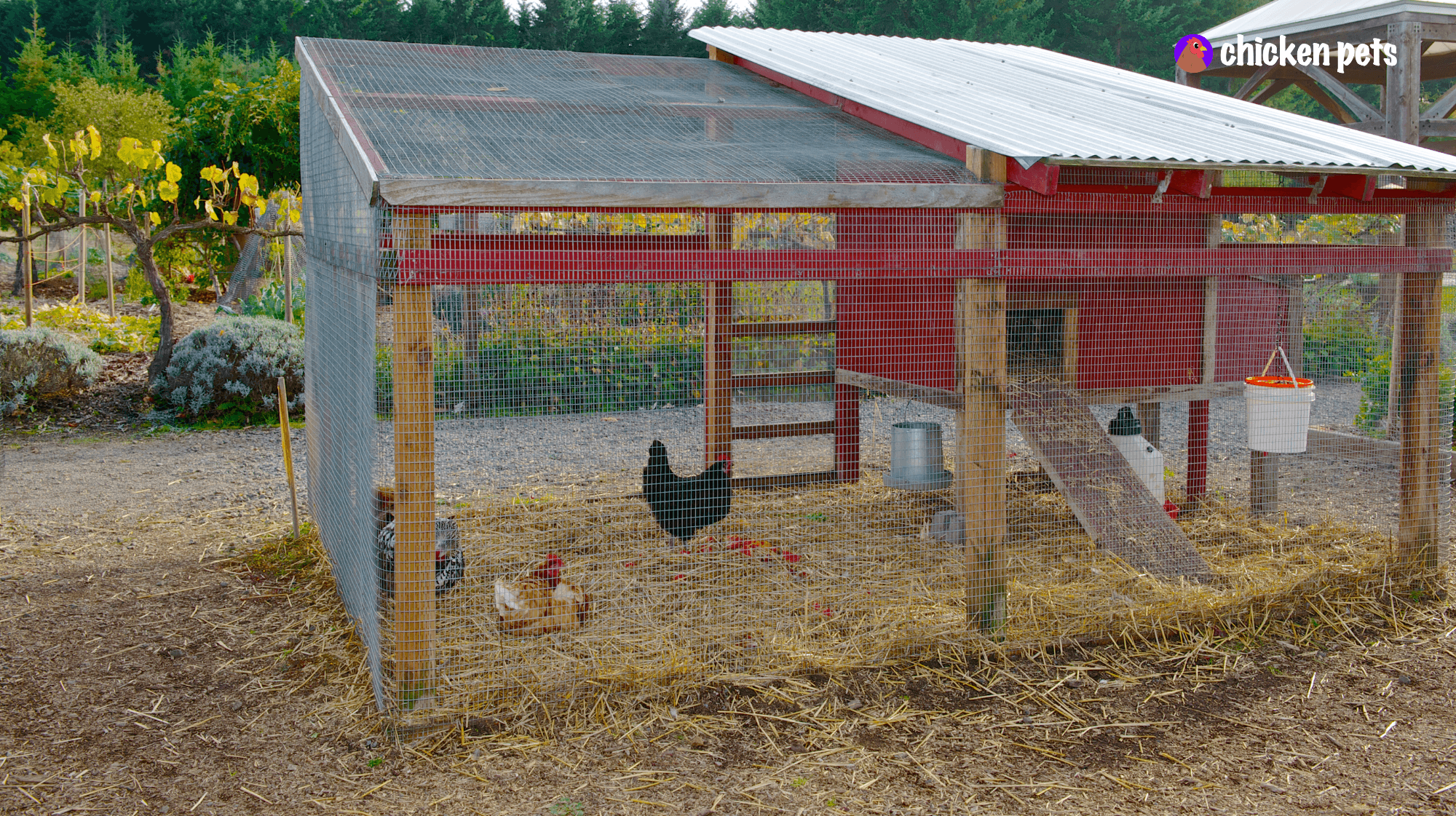
Are you ready to get your hands dirty and build the ultimate chicken palace for your feathered friends? Constructing your chicken coop has benefits, including saving money and customization to fit your needs and preferences. But it also requires effort, time, and planning to ensure it’s safe, comfortable, and functional for your chickens. In this section, we’ll explore the pros and cons of building your chicken coop, provide a step-by-step guide for the building process, and highlight important factors to consider for a successful coop construction project. Let’s get ready to hatch a plan!
Pros of Building Your Chicken Coop: Weighing the Chicken’s Nest
Building your chicken coop can be a fantastic way to save money, get creative, and tailor your coop to your specific needs. But like any project, there are pros and cons to consider before starting. Let’s cluck about the good, the bad, and the egg-cellent opportunities.
- Cost-Effective — Building your coop can be much more affordable than buying a pre-made one, especially using recycled materials.
- Customizable — Building your coop allows you to design the space exactly how you want it.
- Sense of Accomplishment — There’s nothing like standing back and admiring your creation.
- Flexibility — You can modify the coop as your flock grows or changes.
Cons of Building Your Chicken Coop: Don’t Count Your Chickens Before They’re Cooped
- Time-Consuming — Building your coop takes time, especially if you’re a beginner.
- Requires Tools — You’ll need various tools and materials to complete the project, which can be an additional expense.
- Labor-Intensive — Building a coop is hard work, and if you’re not up for a physical challenge, you might want to consider hiring someone to help.
- Lack of Expertise — If you’re new to coop building, you might not know what you’re doing and end up with a less-than-perfect structure.
The bottom line is that building your chicken coop can be a fun and fulfilling experience if you have the time, energy, and resources to do so. Just make sure to weigh the pros and cons before starting to build, so you can make an informed decision and end up with a coop that will make you and your chickens clucking with joy!
Planning Your Chicken Castle

Chickens aren’t just simple feathered friends; they deserve the royal treatment. That’s why it’s crucial to plan the coop of your dreams! Before building, you must determine the size, choose a design, and gather materials.
- Determine the Size — Chickens need space, but not too much space, so measure wisely! Like Goldilocks, your chickens need a coop that’s not too big or small but just right. Consider how many birds you have and how much room they need to roost, lay eggs, and hang out. Remember, overcrowding can lead to stress, fights, and decreased egg production. Measure twice, build once, and ensure your chickens have a palace fit for royalty.
- Choose a Design — The options are cluck-ing endless, from A-frame to penthouse style. The design options for your chicken coop are egg-ceptional! Research, look at pictures, and choose the right design for your chickens and yard. Think about the style of your home and make sure the coop fits in with your aesthetic.
- Gather Materials — Get your saws, hammers, and feathers ready! Once the size and design are down, it’s time to gather materials. This is where your inner carpenter will shine! Make sure you have all the materials you need, such as lumber, screws, and chicken wire, to build a strong, sturdy, and safe coop. Get your feathers ready because building a chicken coop is about to get wild!
Building the Frame: Creating a Home from Scratch
- Assemble the Walls — Time to Roll Up Your Sleeves and Build! Building the walls of your chicken coop is a crucial step, and this is where you’ll start to see your dream of a home for your feathered friends come to life! It’s essential to ensure the walls are secure and sturdy, so take your time and measure twice before making any cuts. And don’t forget to quack up a few jokes while you work!
- Attach the Roof — Now that the walls are up, it’s time to protect your chickens from the elements. Choose a durable and weather-resistant roofing material, and ensure it’s securely attached to the walls. Your chickens will thank you for this little extra bit of comfort.
- Install the Doors and Windows — Chickens love to explore, so make sure you include doors and windows that are big enough for them to pass through comfortably. And remember, you’ll want to be able to clean the coop easily, so make sure the doors are easily accessible. With doors and windows installed, your chickens can come and go as they please. Happy clucking!
Adding the Finishing Touches: A Coop Fit for Kings and Queens
- Paint and Decorate — It’s time to give your coop a little personality and pizzazz! Whether you choose bright red, cheerful yellow, or a calming green, the paint will give your coop a pop of color that will make it stand out. Don’t be afraid to get creative, either. You can add a mural or wall art to make your coop unique. After all, your chickens deserve a palace, not just a house.
- Insulate and Ventilate — Like us, chickens need to stay comfortable, no matter the weather. Insulating your coop will keep them warm in the winter, and adding ventilation will keep the air fresh and healthy. So, add plenty of insulation and roof vents to ensure your chickens live their best lives.
- Add Flooring — Your chickens deserve a soft place to stand, so why not add some flooring to their coop? Whether you choose soft pine shavings, cozy straw, or durable rubber matting, your chickens will love having a place to rest their feet. And, who knows, they might even lay a few extra eggs just because they’re so happy!
Installing the Run: Free-Range Fun!
- Plan the Run — How much space do your chickens need to roam and play? Prepare your measuring tape and plan a run to keep them happy and healthy.
- Build the Run — Time to get those building muscles ready! Make sure the run is secure and safe for your feathered friends. They deserve the best!
- Attach to Coop — It’s time to bring the coop and run together like two peas in a pod. Your chickens will love being able to move freely from one space to another. No more coop confinement for these birds!
All Set for Your Feathered Friends: Home Sweet Coop
- Fill with Bedding — Give your chickens royal treatment with a soft and cozy bedding fit for a flock of princesses (or prince-chicks).
- Add Food and Water — No royal court is complete without sustenance, so ensure your chickens have plenty of food and water to keep them feeling peckish and quenched.
- Add Perches — Last but not least, provide a perch fit for royalty, where your chickens can rest their feathers and survey their kingdom in comfort. With all these elements, your chicken castle will be ready to welcome its new residents!
The article is a chapter from our book. Keep reading the chapters below.

- Backyard Chickens: The Beginners Guide
- Chapter 1: Raising Chickens in Your Backyard. Pros, Cons, Costs
- Chapter 2: Chicken Coops. Components, Buying, Building
- Chapter 3: Chicken Breeds for Beginners. Where to Start
- Chapter 4: Baby Chicks. Everything You Need to Know
- Chapter 5: Feeding and Watering Chickens Ultimate Guide
- Chapter 6: Chicken Health and Hygiene: The Master Guide
- Chapter 7: Chicken Eggs. The Incredible Edible Egg!
- Chapter 8: Chicken Psychology and Behaviors
- Chapter 9: Chicken Shit. Quality, Consistency, Color, Smell
















